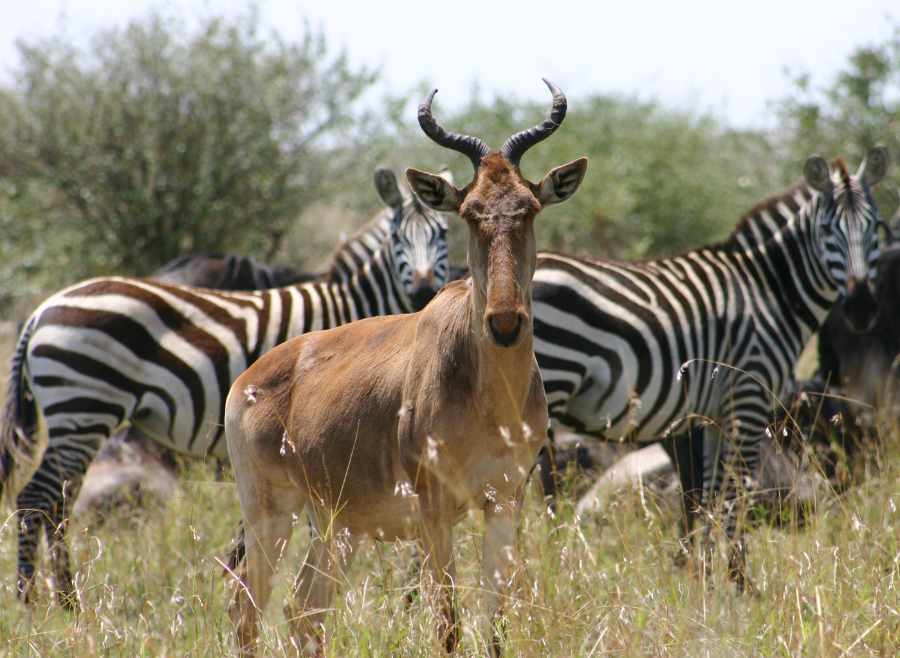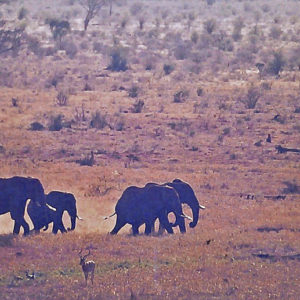Right from the earliest pre-colonial days, prominent personalities at home and abroad echoed the call for conservation. Under pressure from big game hunters in particular, wildlife was under threat from the start and visitors like Cherry Kearton in the early years of the twentieth century bemoaned the inevitability of a great and impending loss. In the 1940s and 50s, the colonial government set aside vast tracts of land as preserves for wildlife and this network of parks and reserves has been maintained intact, and extended, into the present era. The network of national parks and game reserves was designed to reflect the vastness and diversity of Kenya’s landscapes and wildlife in the days before the word ‘biodiversity’ was even coined. The amount of land set aside and the range of habitats covered remains one of the world’s finest contributions to conservation, a legacy which Kenya can be proud to hand on to subsequent generations.
Of more than fifty parks and reserves – and several additional sanctuaries and forest reserves – here are just a few examples . . .
Tsavo National Park, both east and western sectors, totals over twenty thousand square kilometres of rolling plains, rugged mountains, and arid thornbush scrub intersected by the dramatic Tsavo and Galana Rivers. The park includes Mzima Springs, a freshwater spring which bubbles up from beneath the lava flows of the Chyulu Hills and which is home to large numbers of hippo. A very wide range of wildlife species occurs in Tsavo but animals can sometimes be difficult to find in this vast landscape of spectacular scenery.
Fringing the semi-deserts in the lower lying terrain to the north of Mt Kenya lies a trinity of contiguous reserves, Samburu, Buffalo Springs and Shaba. Flowing as a life-giving artery through the heart of the ecosystem is the Uaso Nyiro River, dripping with doum palms, much frequented by crocodiles and providing sustenance to herds of elephant. Typical species in this northern area are oryx, gerenuk, Grevy’s zebra and reticulated giraffe.
The Aberdares National Park comprises a range of forested foothills and mountain moorlands from 6,000′ to the peak of Satima at over 13,000′.The slopes are clad in dense rain forest and bamboo which, in the Salient section of the park, provides refuge for elephant and rhino. There are some spectacular waterfalls, including the Karura Falls which tumble some 900′ into an inaccessible forested valley.
Close to Kitale in the west of Kenya lies the tiny enclave of Saiwa Swamp National Park, established to protect Kenya’s only group of marsh dwelling sitatunga antelope which can be viewed from tree platforms.
Surrounded by steaming geysers and bubbling hot springs, deep inside a fold of the Great Rift Valley lies Lake Bogoria, protected as a national reserve and home to millions of flamingoes. The flocks sometimes nest here but the nature of their erratic mass movements across east Africa remain something of a mystery.
Just inland from the coastal resort of Diani is the Shimba Hills National Reserve, a range of rolling, park-like hills just an hour’s drive for the holiday hotels. This is the only location in Kenya where the splendid sable antelope is found.
Nairobi must surely be the only city in the world with its own national park and herds of wildlife right on its doorstep. Barely fifteen minutes drive from the city centre, you can be amongst huge dry season concentrations of antelopes, zebra, wildebeest, buffalo and giraffe. Lion, cheetah, hyena and rhino can all be found here just outside the city limits.
But in spite of this impeccable and incredible asset, there is no doubt that wildlife remains under serious threat. There are people who feel that conservation has faltered in Kenya, lost in a Byzantine maze of politics, recriminations and greed in which voice-less and vote-less animals literally have no say. The figures tell a sorrowful message: wildlife numbers decreased by over 50% during the eighties and nineties outside controlled areas and by over 30% in parks and on private land. Massive exterminations have taken place in southern Masailand, and in northern and north eastern parts of the country. At present, numbers are considered to be stable only on private ranches in Laikipia, Rift Valley and Machakos districts.
Weighed against the critical value of wildlife as part of Kenya’s natural wealth, the failure of conservation must be considered as a potential disaster to the country and its economy. In considering how this situation has arisen and what can be done about it, it is important to note that it is not that the problems are not recognised but rather that solutions on offer span too wide and mutually incompatible extremes of opinion.
Land ownership
Many of the issues impacting upon conservation are connected with ownership and use of land. Kenya has undergone major transitions in a relatively short historical span of time. These have involved a substantial growth in population, as well as large shifts in ownership of land as title has devolved from the former dominance of traditional ‘public’ ownership more and more into private hands, often of smallholder farmers. In a country with a low industrial base such as Kenya, the majority of its people depend on agriculture, often subsistence farming – where they grow the crops that feed the family. The need for land for farming puts people into direct competition with wild animals which also need the same land for much the same purpose. Left to their own devices, people would mostly prefer to eliminate the animals, particularly the larger and more dangerous species such as buffalo, elephant and lion.
In Kenya, politics permeate virtually every aspect of society. In a democracy people have votes, but wildlife does not possess a constituency and cannot easily garner political support. Hence public attention and government action tends to follow human priorities, sometimes to the detriment of wildlife. History shows however that people can often come to an accommodation and live alongside less threatening wildlife species. On this positive side, there has been a growing trend for private land owners, both traditional communities as well as individuals and corporations, to recognise and accept their own responsibilities in conserving the wildlife on their land. In several parts of the country, large scale land owners have come together in forums to represent their common interests and to lobby for appropriate policies and legislation, as well as providing a common voice in negotiating with government and other stakeholders. Success stories in this area abound, including for example the ownership and management of the Masai Mara by the indigenous community, of the Lewa Downs Conservancy, one of several large private ‘farms’ in the Laikipia district, and group ranches in the Taita district.
Ownership of wildlife
In Kenya, unlike many other countries, wildlife is ‘owned’ by the state. This creates a dilemma for land owners. At one extreme, if elephants are destroying your crops, you have no right to stop them. At the other, if you want to breed and manage herds of, say, antelope on your ranch, as you would cattle, you have no right to do so. The reality is that both situations do actually take place, flying in the face of unenforceable legislation and an insufficiently resourced ranger force. The fear that delays any change in the law is that landowners will simply wipe out the wild species that get in their way. The probability in fact is that a middle route can and must be found. In many other African countries, wildlife numbers have increased dramatically, especially on large privately owned ‘game farms’, as landowners have adopted wildlife as a money-making resource.
Good stewardship upon which a sound conservation strategy can be built is most likely to be nurtured by stakeholders who possess a vested interest in the resource they are conserving. The most viable and sustainable solution will probably require not legislation but rather a balance of incentives.
Wildlife utilisation
If there is one debate in Kenya which sparks controversy and emotion it is that between the promoters of the unrestricted utilisation of wildlife as an economic resource versus those who would prefer to ruthlessly protect wildlife from all external impacts and influences. Unfortunately for wildlife, the debate has been characterised less by rational dialogue and a search for common ground than by an unbridgeable polarisation of opinion and lack of consensus. Utilisation falls into two main segments. Consumptive utilisation comprises cropping for meat and hides, live capture for zoological collections, research purposes and the pet trade, and sport hunting. Non-consumptive utilisation involves no killing – this means primarily wildlife tourism and photographic safaris.
The consumptive lobby has a lot of sound economic argument on its side. Landowners suffer from their obligation not to interfere with wildlife, so they have no incentive to conserve. Rather they possess strong incentives to eliminate wildlife, out of the sight and reach of the authorities. Would it not make more sense, they say, to give us ownership and stewardship of the wildlife as an incentive to manage it in everyone’s best balance of interests? Proponents may also point to massive abuses of the present law, where slaughter of wild species continues unabated, feeding meat and hides into a clandestine butchery trade across the country. Why ban wildlife consumption, they would ask, when a) it happens anyway and b) the government does not possess adequate resources to enforce it?
But the anti-consumption group would claim to have history on its side, at least so far as hunting is concerned. It became a free for all shoot-out, they might say, with carnage and carcasses all over the place. Hunters, it is claimed, abused the limitations of their licences and massive poaching, for example for ivory, took place under the guise of safari hunting. True or not, the only way to prevent this from happening again, goes this argument, is to ban all forms of consumptive utilisation.
After lengthy deliberations and the sometimes vociferous presentation of cases on both sides of the debate, the jury is still out. There appears to be regrettably little meeting of minds over a common middle position.
The environment
Changes in land use and climate have had an inevitable impact upon Kenya’s environment and landscape. Wheat fields surround much of the northern Mara conservation area. Forests have been slashed and burned on mountain catchment areas across the country, including on the Mau, Chyulus and Mt Kenya. Watercourses have become less consistent and in some cases more polluted. Allocation of land into private hands has led to settlements and fences blocking migration routes. This is particularly worrisome in several high visibility and high density wildlife locations. From the Aberdares range, elephant were formerly able to migrate seasonally across the plains to Mt Kenya and to the north into Laikipia. Settlements have blocked the routes, bringing the elephants into conflict with farmers. The solution in this case has been the charitably funded Rhino Ark project which aims to fence the entirety of the Aberdares National Park. While there is little doubt that this will delight the farmers, the long term effects of creating a closed ecosystem have yet to be fully understood.
Complete ring fencing has also been the preferred solution in the case of Lake Nakuru National Park. This too has prevented crop raiding by animals while simultaneously halting encroachment into the park. However, it risks the accusation that the park is now an artificial ecosystem little different from a large zoo. Along the Kitengela boundary of Nairobi National Park, housing and farms have now seriously constricted the migration routes of plains game in and out of the park. The long term potential could be a disturbingly complete loss of the ebb and flow of the natural ecosystem, thus reducing the viability of the park as a viable tourist attraction. Deforestation and human settlement on the Mau catchment area for the Mara River are feared in the long term for their potential to reduce the river’s flow and thereby reduce its value in watering the western part of the Masai Mara reserve which presently forms the country’s greatest wildlife attraction.
Again, no easy solutions are in sight.
Conservation management
The responsibility for the management of wildlife in Kenya is entrusted to the Kenya Wildlife Service, KWS. Non-government organisations have also played an important role. These have included the African Wildlife Foundation, African Conservation Centre, East African Wildlife Society and the World Wildlife Fund. The ability of any and all of these organisations to succeed has inevitably been compromised by the factors mentioned above. But the management of KWS itself has become highly politicised and no single incumbent director has consistently been able to move forward with necessary changes. Indeed over the years, in spite of great attempts to ‘professionalise’ the service, some policies have been introduced which could be called misguided.
Although historically the majority of Kenya’s wildlife exists outside of protected areas, little has been done to ensure its sustainability in such areas. Some effort has been made to encourage traditional community based landowners to conserve and benefit from wildlife. But the benefits have proved elusive and assistance programmes to create ‘ecotourism’ attractions have often lacked the commercial viability demanded by the realities of the marketplace.
The pricing of park entry has also generated its share of controversy, resting on the argument that wildlife should pay its way and that foreigners can afford a certain fee level. But an entry fee of, at present, up to US$60 per person per day can have a disincentive cost multiplier effect on overseas holiday packages and encourage shorter stays. Commercially, the wisdom might reasonably be questioned of maintaining high prices over a period of decline in tourist numbers. At the other end of the scale, reduced fees have been made available to Kenyans but there is little evidence that this has had a measurable positive impact on either revenue or visitor numbers, while the pricing policy is open to accusation of a racial bias as park gate officers demand evidence of citizenship upon entry.
A further oddity of policy relates to the introduction of alien species in certain parks. Biologists tell us that one of the greatest detrimental effects on an indigenous ecology can be devastation by species from outside which devour either the local species or the food upon which they depend. They may also bring disease or other complicating factor which can be difficult to forecast. Yet several alien introductions have been made into Kenyan parks and reserves in the name of tourist attraction. These have included bringing lions into the Aberdares moorlands, which has resulted in a major loss of bongo and giant forest hog, chimpanzee ‘orphans’ into a resettlement programme on a Laikipia ranch, and importing South African white rhinos into the Mara and Lake Nakuru National Park.
Security and infrastructure
Other issues impacting wildlife and conservation are more generally applicable to the present situation in the country overall. The state of Kenya’s roads is probably the one factor that most visitors notice most readily. This significantly lengthens travel times and increases transport operating costs.
Another key issue is insecurity which has adversely affected travel to and within the country, as well as contributing to a lack of enforcement of applicable wildlife regulation and legislation.
Window on the world
But wildlife is not just about tourism and conservation. Kenya has long been a favourite with photographers and film makers due to its reliable sunshine, scenic variety and the relative ease of access and close approach to its wildlife. Cherry Kearton has been followed over the years by a vertiable lineage of cinematographers. Armand and Michaela Denis put Kenyan wildlife onto British television in the 1950s with their ‘On Safari’ programme. Joy and George Adamson came to fame along with rehabilitated lioness Elsa when ‘Born Free’ was published in the late 50s, quickly followed by a series of films during the early 1960s. George later earned a place in conservation history when he lost his life to a gang of armed poachers. The Kora reserve where he was based was subsequently declared a National Park in his memory.
‘Out of Africa’, the film based on Karen Blixen’s 1930’s life of adventure involving coffee farming and love affairs with hunters such as Denys Finch-Hatton, came out in 1986 and led to a surge in tourism to Kenya. Artist and photographer Jonathan Scott has more recently put the Masai Mara indelibly on the wildlife map with his presentation of TV programmes such as Big Cat Diary. He and many others have ensured that Kenyan wildlife stars on broadcast channels around the world such as National Geographic, Discovery Channel and the BBC as well as in Canada, Australia and Japan.
Biologists, ecologists and behavioural scientists too have found important revelations in Kenya. In Amboseli National Park for example, a team led by Cynthia Moss has discovered how elephants talk to each other using infra-sound.
In spite of the difficulties and challenges, Kenya’s wildlife has proved resilient and continues to contribute to the country’s image of excitement and attraction all over the world. Visitors and Kenyans alike can still enjoy the exhilarating freedom of a game drive across the Mara savanna and see not another vehicle for hours on end. They can marvel at the stunning sight of a majestic bull elephant framed by flat-topped acacia trees against the crystal backdrop of the snows of Kilimanjaro.
It’s August and the wildebeest are trekking into the Mara . . . it’s April and the zebra foals are dropping onto the Athi plains . . . it’s January and the elephant are back on the Uaso Nyiro River . . . the excitement and delight will never fade.


